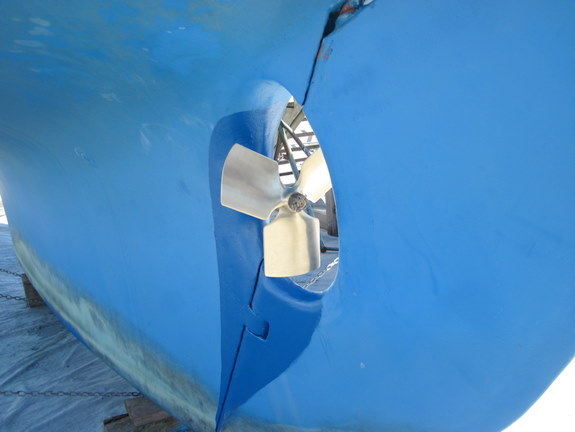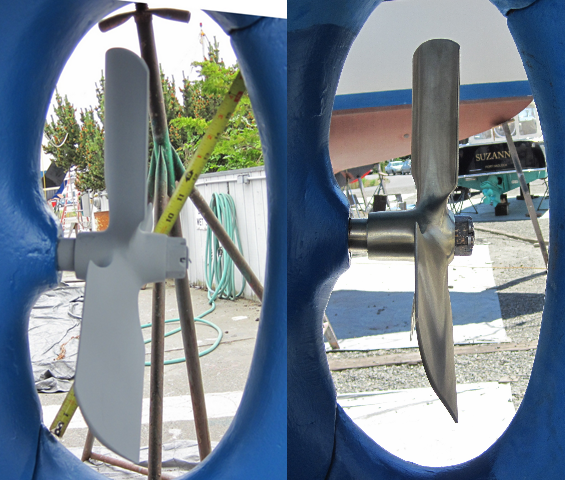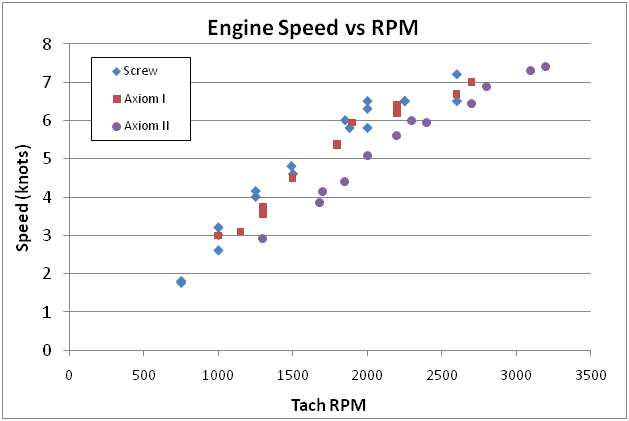Prop Analysis and Replacement – Part III: The Second Axiom Prop

July 28th, 2011 | by Van | Published in Maintenance and Repairs, Upgrades | 1 Comment
We hauled out on July 21st, hoping to “haul and hang” for an hour to pull off the old Axiom and put on the new one, but with the nagging fear in the back of our minds that we should have replaced the white metal bearing during our haul out in June. We were worried that the new Axiom prop vibration was affecting the bearing and potentially our transmission – and we’d just spent a week cruising in the San Juan Islands with the new prop, so perhaps the damage was already done. When we grabbed the prop and shook it, it was clear the bearing was loose, perhaps even more so than in June. In any case, it was time to change it, so we spend an extra four days on the hard.
The new prop was clearly smaller than the previous one, both in terms of diameter (3/4″ less) and also blade width, making the overall surface area quite a bit smaller. Interestingly, the first Axiom prop was really hard to get off, even though it had only been on for about a month.
As before, the new prop fit just fine on the shaft, and we lapped the prop hub against the shaft with a special lapping compound designed for bronze. We applied a very thin layer of Tef-Gel to the shaft and installed the prop. The Tef-Gel does not affect the electrical conductivity between the shaft and prop, which is important for the bonding connection to the zincs, but hopefully will make it easier to remove next time.
This time, the prop (right) is nicely centered in the aperture, with a good two inch clearance at top and bottom from the deadwood and rudder, clearly better than the first prop (left).

BTW, you’ll note we did not paint the new prop with Petit Zinc Coat Barnacle Barrier (which is grey) like we did the first one, because after just a month in the water, the Zinc coat was substantially gone – it looked as if it had not adhered well at all even though we carefully degreased the prop before applying the coating.
Underway again
Back in the water, the first thing we noticed was that the “bite” on the water was less than before. In a way, that’s a good thing, because it means you can idle the boat in gear, without it trying to take off. But it does mean you have to apply more RPM to get it going.
I’m pleased to say that in reverse, the Axiom prop again has little if any prop walk, and has plenty of power to stop the boat and get it going backwards in a straight line. However, it does need a lot more RPM to get moving than the first Axiom prop.
Next, the WOT max RPM is 3350 (corrected for tachometer calibration), which shows this new prop is still a little over propped, as it maxes out at a few hundred RPM less than the maximum intermittent duty rating for the engine (3600). That, if you recall, was the design goal set by Gerr. But this is close enough, and much better than being under propped. At this RPM, Rainshadow moves along at just over 7 knots, close to hull speed.
Unfortunately, the prop still creates deep rumbling sounds at about 2600 RPM, which I believe may be the onset of cavitation. The rumbling is loud but not so loud that it is too scary to increase the RPM still further. At WOT, the rumbling is just bearable. Cavitation is basically a function of the force (thrust) applied by the prop surface divided by the area of the prop surface, so the smaller blades of the new prop have not helped with this. It would be interesting to try a four blade version!

Now at last, we have a prop that solves the three problems we had at the start: firstly, the cavitation is much reduced, and the sound level even at high RPMs is bearable; secondly, overall propeller noise is reduced, especially at cruising RPMs; and thirdly, the propeller is not over propped – at least by not much. In addition, we have much greater control over the boat when motoring in reverse because there is significantly more thrust, and essentially no prop walk. With the old screw prop, we could only reach 7 knots at unbearable levels of noise, and could motor happily only at about 5.5 knots. Now, we can reach about 7.5 with a bearable noise level, and can cruise at 6.0 – 6.5 knots very comfortably. The cruising RPM we use is now about 2300 – 2500 RPM, and the engine seems quite smooth.
Would we recommend Axiom props to other cruisers? The two main advantages of the Axiom are reduced noise, and excellent thrust in reverse, with no prop walk. If these are important to you, then yes, the Axiom is a very good solution.
We also give Axiom Propellers Ltd. 10 gold stars for customer service! They stuck by their promise to make us a prop that works, even when that required they develop “Axiom Mark II” so it fits centered in the Nic 38 aperature. They made this second prop with only about a 3.5 week turnaround, including the time for design, casting, finishing and shipping from the UK to US.
To read about what lead to this, see Part I for analysis, and Part II for the results of the first Axiom prop.
May 13th, 2014at 10:56 am(#)
Great information very well thought out and written. Thank you.